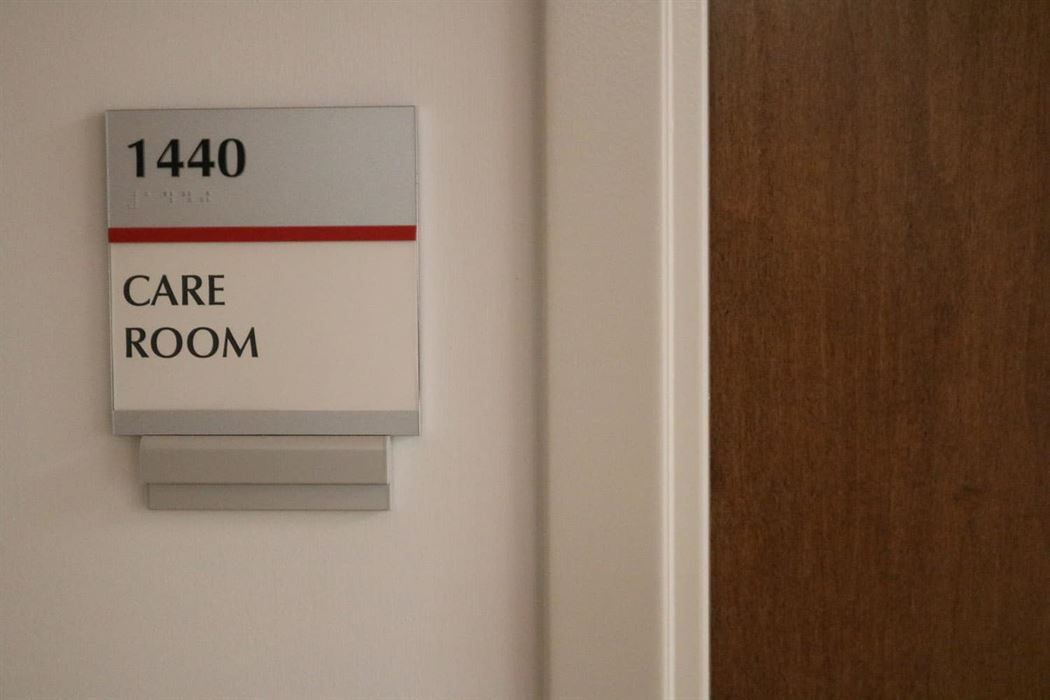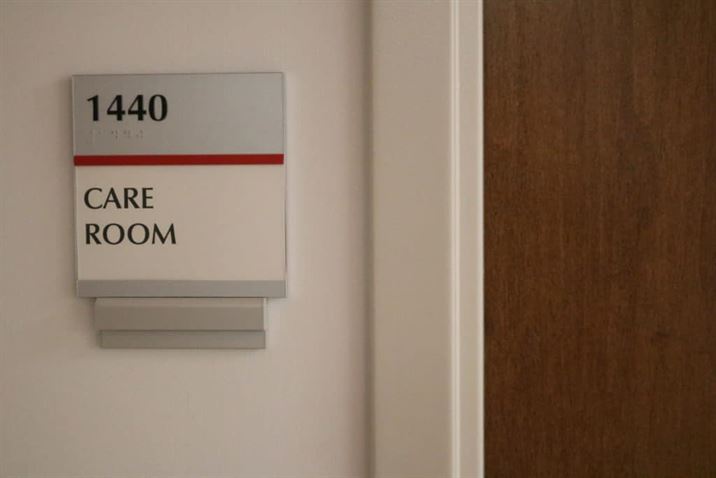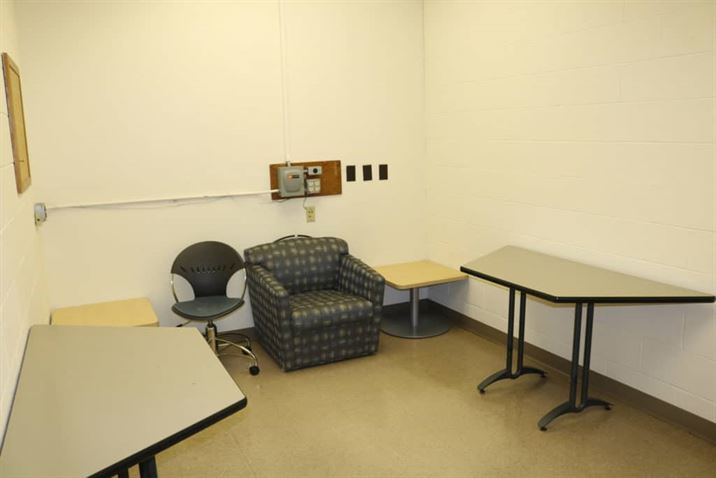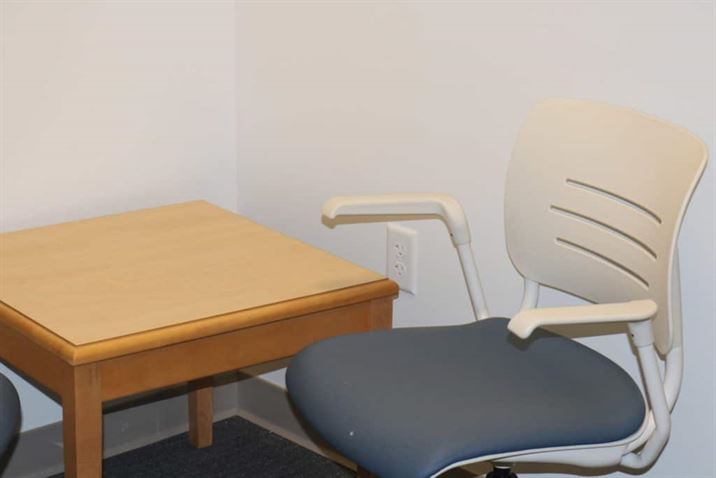
Reshma Adwar (left) and Ayla Gentiletti (right) push for updated facilities.
Photo Credit: Dana Jarvis
When it comes to feeding their babies, women are told breast is best. However, researchers studying barriers to breastfeeding suggest that while mothers may have the intention to breastfeed, they may not have the appropriate support. Particularly on college campuses, students, professors, and staff struggle to continue breastfeeding due to a lack of pumping spaces or time.
The American Academy of Pediatrics recommends children be exclusively breastfed for the first 6 months of life, followed by a combination of breastmilk and complementary food until the age of 1 year. Breastfeeding is beneficial to both baby and mother. It has been shown to protect infants from diseases such as respiratory tract infections, Types 1 and 2 diabetes, leukemia, and childhood obesity. For the mother, it decreases the risk of breast and ovarian cancers, decreases postpartum bleeding, and promotes postpartum weight loss. Breastfeeding encourages bonding between mother and baby, and provides a safe, economical, readily-available source of nourishment for the developing infant.
Alternatively, ending a breastfeeding relationship can deprive a baby and mother of the unique bonding experience of breastfeeding and can pose a financial burden on new parents. Baby formula can cost $1600 to $2000 per year on top of expected baby-related expenses such as diapers, clothing, child care, etc.
Breastfeeding is challenging and can be difficult to initiate and maintain. According to a 2011 report by the office of the Surgeon General, breast pain, poor infant latch, maternal feelings of isolation or loss of freedom, and negative social attitudes toward breastfeeding are common obstacles surrounding an ongoing breastfeeding relationship. Returning to work or school is another significant barrier, particularly when women do not have the appropriate facilities or time to privately, comfortably and hygienically express and store milk. Consequently, women may end up abandoning breastfeeding altogether.
According to a report by the Centers for Disease Control (CDC), among infants born in 2013, 81.1% started to breastfeed, however, at 6 months and 12 months, that number dropped to 51.8% and 30.7% respectively. Although this is an increase from previous years, it is evident that infants are still not being fed as per recommendations. The CDC postulates that this is likely in part due to mothers not getting the support they need.
The Patient Protection and Affordable Care Act of 2010 addresses these barriers and mandates that companies with 50 or more employees provide a nursing mother reasonable break time and a private space other than a bathroom to express breast milk. Universities are in a unique position because they are accountable not just to employees, but also to students. Even if they are following the requirements of the Affordable Care Act as it relates to employees, they also have the responsibility to meet the needs of lactating students.
According to Nyreen Seguinot, a senior at Montclair State University who is currently nursing her baby, “Pumping while at school is a task within itself. Mothers who continue to do so need as much support as they possibly can get.”
Examining universities across New Jersey, we found that some have no lactation policies outlined on their websites while others have very basic accommodations. Universities that have no listed policies include Seton Hall University, Stevens Institute of Technology, William Paterson University and Georgian Court University.
While these universities may have policies that are known to students and staff internally, an inability to find information through an internet search sends the message that these policies and facilities do not exist.
On the basic end of the spectrum are universities which have few lactation spaces, simple furniture, limited hours of operation and require women to bring their own pumps and supplies. Rutgers, Rowan and Princeton Universities and The College of New Jersey are examples.
There are no universities in New Jersey which exceed this basic level of policies and facilities for lactating students. However, across the country, there are several universities with model accommodations. These universities have several lactation spaces across campus featuring plush furniture, hospital grade pumps for student use, extended hours of availability, refrigeration and clear policies outlined on their websites including photos of the spaces, location of the rooms and contact information for questions or concerns. The University of Wisconsin-Madison, Texas A&M University, George Washington University, and the University of Arizona are examples.
We sought to assess lactation policies and facilities at Montclair State University to determine where they fell on the spectrum of basic to model. We investigated the feasibility of accessing designated lactation rooms and how well lactation policies are both understood and enforced. As per the university’s website, there are currently two lactation rooms on campus, located in Richardson Hall and the Center for Clinical Services in Lot 60. Lactation rooms are available from 8:30 a.m. to 4:30 p.m., Monday through Friday. To access a space, mothers must first email the Women’s Caucus for approval.
Following this procedure, we sent an email to the Women’s Caucus on a Tuesday to reserve space in Richardson Hall for that upcoming Friday at 10:45 a.m. By Friday morning, we received no reply. Nonetheless, we visited the Richardson Hall lactation space. The room was unlocked and occupied by university staff treating it as a break room. While the space was large and adequately furnished, it was unclean and malodorous— not an ideal environment to pump.
We also visited the lactation room in the Center for Clinical Services, located in Lot 60. The space provided basic essentials for pumping, including a table, chair, electric outlet, and was clean. While clinic staff were very accommodating and aware of the lactation policies, use of the space presents its own set of obstacles.
After 3 trial runs, we found the average amount of time needed for transportation to and from University Hall, pumping, and clean-up to be 1 hour. If a woman has class elsewhere on campus, this time could increase. Even though the room was adequate, due to the time needed to access it, it was not a reasonable option for a woman who has multiple classes or activities on the main campus.
Our experience was echoed by several students and staff who have attempted to pump on campus. Seguinot noted, “I emailed the Women’s Caucus in reference to a lactation room and received no response. I proceeded to contact the Health Center and Human Resources, left voicemails for both offices, yet received no response.”
For the first several days of the spring 2017 semester, Seguinot was forced to manually pump in her car, a situation she described as “uncomfortable.”
Further, a 2015 study by Dr. Lauren Dinour at Montclair State University notes that a lack of conveniently-located lactation spaces—sometimes requiring women to spend an hour accessing and using—are a barrier to pumping on campus.
Seguinot eventually found space, but not by following campus policy. “It wasn’t until I contacted the Women’s Center that I was finally able to get information and access to a lactation room [in the Student Center],” she said.
This room, however, is not highlighted on the Montclair State website, a flaw Cindy Meneghin, director of Student Communications, recognizes. As the Chair of the President’s Commission on Affirmative Action, Equal Opportunity and Diversity, Meneghin and her colleagues have advocated for improved lactation policies on campus and are currently working toward change.
Meneghin’s team has identified several spaces throughout campus to be converted into lactation rooms. All rooms will have comfortable furniture, a sink and the ability to lock from the inside. Additionally, women will not have to send requests through email to reserve space. All rooms will be accessible via 25 Live, a web-enabled scheduling tool.
Mothers will be able to reserve space at the time and location most convenient for them without advance approval.
Meneghin and her colleagues plan to unveil these newly remodeled locations in the coming weeks. Ultimately, Meneghin pictures a campus that provides care rooms in every other building, accessible to faculty, staff, students and visitors.
Meneghin and her team are not alone in their concern. Dr. Tamara Lucas, Dean of the College of Education and Human Services, is also conscious of the need for improvement. Before the semester ends, she plans to remodel an existing office on University Hall’s third floor into a care room for new mothers. Unlike the current campus policy, Dean Lucas intends to make the room available beyond the weekday-only, 8:30 a.m. – 4:30 p.m. parameters.
As Seguinot states, “The university recognizing this population will encourage mothers to enroll in classes without sacrificing their ability to nurture their baby. Providing information and having rooms readily available is a key factor in improving already existing accommodations.”






